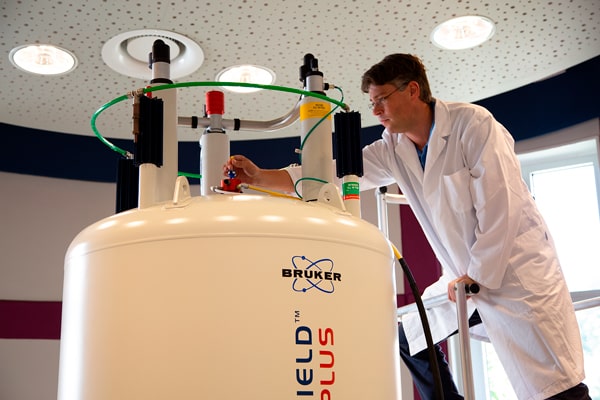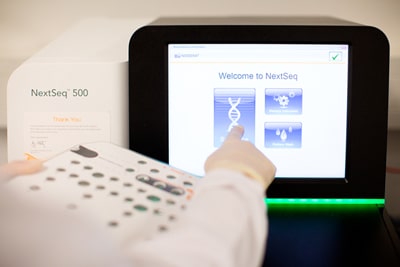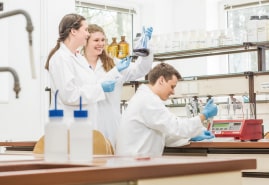We do it without thinking about it: a healthy adult breathes about 12-15 times per minute and supplies the body with vital oxygen in this way. If the lungs become diseased, this natural process gets out of sync and the oxygen supply is impaired. The consequences can be serious: According to the World Health Organization (WHO), lung diseases are currently the second most common cause of death worldwide and the number of cases will continue to rise in the coming years.
The Research Center Borstel, Leibniz Lung Center, is entirely dedicated to the lungs and researches and treats inflammatory lung diseases, with a special focus on allergic asthma, chronic obstructive pulmonary disease (COPD) and tuberculosis (TB). To conduct research at the highest level, many buildings have been constructed on campus over the years.
On the left side you can see the laboratory building PA22. The 68m long clinker building was inaugurated in 1984 and has been the central research building on campus ever since. It houses laboratory and office rooms as well as the animal husbandry of the research center. The building is now very much in its infancy. Renovating the building would have cost more money than building a new one, and so the decision was made in 2016 to construct a new laboratory building on the campus, which should be ready for occupancy in 2023.

However, PA22 is far from housing all of the research groups: to the south of the mansion are several laboratory buildings, some of which house very large analytical instruments, such as mass spectrometry (MS) and nuclear magnetic resonance (NMR) spectroscopy.

To the right, you can see other buildings that have been added to the existing buildings more recently due to the ever-increasing need for space:
A building from the 1980s, in which many researchers have their offices, and a laboratory flat building from 2011, which, in addition to modern research laboratories, also houses the laboratories for trainees.

The Research Center Borstel, Leibniz Lung Center not only promotes young scientists through the "Borstel Biomedical Research School" and the "Postdoc Initiative", but also trains young talents as biology laboratory assistants. The training at the Research Center Borstel, Leibniz Lung Center (FZB) lasts a total of 3.5 years and is divided into a one-year basic training and a subsequent practice-oriented part, during which the trainees work in different research laboratories on campus. This practical work is accompanied by vocational school instruction in Lübeck.
Additional facilities are needed to maintain this infrastructure: In addition to the researchers, the buildings on campus also house the technical building management, IT, the works council and the administration.
Wir tun es, ohne darüber nachzudenken: Etwa 12-15 Mal atmet ein gesunder Erwachsener pro Minute und versorgt den Körper auf diesem Wege mit lebenswichtigem Sauerstoff. Erkrankt die Lunge, gerät dieser selbstverständliche Prozess aus dem Takt und die Sauerstoffversorgung wird beeinträchtigt. Die Folgen können gravierend sein: Laut der Weltgesundheitsorganisation (WHO) stellen Lungenerkrankungen aktuell die zweithäufigste Todesursache weltweit dar und die Zahl der Krankheitsfälle wird in den nächsten Jahren weiter ansteigen.
Das Forschungszentrum Borstel, Leibniz Lungenzentrum, hat sich gänzlich der Lunge verschrieben und widmet sich der Erforschung und Behandlung von entzündlichen Lungenerkrankungen, mit einer besonderen Schwerpunktsetzung auf allergisches Asthma, chronisch-obstruktive Lungenerkrankungen (COPD) und Tuberkulose (TB). Um Forschung auf höchstem Niveau zu betreiben, sind im Laufe der Jahre viele Gebäude auf dem Campus erbaut worden.
Auf der linken Seite sieht man das Laborgebäude PA22. Der 68m lange Klinkerbau wurde im Jahre 1984 eingeweiht und stellt seitdem das zentrale Forschungsgebäude auf dem Campus dar. Es beherbergt neben Labor- und Büroräumen ebenfalls die Tierhaltung des Forschungszentrums. Das Gebäude ist mittlerweile stark in die Jahre gekommen. Eine Sanierung des Gebäudes hätte mehr Geld gekostet, als der Neubau und so entschied man sich im Jahr 2016 ein neues Laborgebäude auf dem Campus zu errichten, welches im Jahr 2023 einzugsbereit sein soll.

In der PA22 sind aber bei Weitem nicht alle Forschungsgruppen untergebracht: Südlich des Herrenhauses befinden sich mehrere Laborgebäude, die zum Teil sehr große analytische Geräte, wie die Massenspektrometrie (MS) und die Kernspinresonanzspektroskopie (NMR) beherbergen.

Zur Rechten sieht man weitere Gebäude, die in der jüngeren Zeit aufgrund des immer weiter steigenden Platzbedarfs zu den bestehenden Gebäuden hinzugekommen sind:
Ein Gebäude aus den 80er Jahren, in dem viele Forschende ihre Büros haben und ein Laborflachbau aus dem Jahr 2011, der neben modernen Forschungslabors ebenfalls die Laboratorien für die Auszubildenden beherbergt.

Denn das Forschungszentrum Borstel, Leibniz Lungenzentrum fördert nicht nur den wissenschaftlichen Nachwuchs durch die "Borstel Biomedical Research School" und die "Postdoc Initiative", sondern bildet ebenfalls junge Talente als Biologielaborantinnen und Biologielaboranten aus. Die Ausbildung am Forschungszentrum Borstel, Leibniz Lungenzentrum (FZB) dauert insgesamt 3,5 Jahre und ist in eine einjährige Grundausbildung und einen anschließenden praxisorientierten Teil gegliedert, bei dem die Auszubildenden in unterschiedlichen Forschungslaboratorien auf dem Campus arbeiten. Begleitet wird diese praktische Arbeit durch den Berufsschulunterricht in Lübeck.
Um diese Infrastruktur zu unterhalten, bedarf es zusätzlicher Einrichtungen: Neben den Forschenden sind in den Gebäuden auf dem Campus ebenfalls das Technische Gebäudemanagament, die IT, der Betriebsrat und die Verwaltung untergebracht.